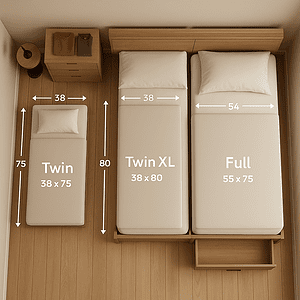
Furnishing a small bedroom or studio apartment can feel like solving a puzzle. You want comfort, style, and function all in one, without overcrowding the space. At the center of it all lies one of the most important decisions you’ll make—choosing the right mattress size. A mattress isn’t just a sleeping surface; it affects how you move around the room, how much storage you can use, and how cozy your living space feels. That’s why understanding the dimensions listed in a mattress size chart becomes especially important when space is at a premium.
For people living in cities, minimalist homes, or compact apartments, choosing the ideal mattress size requires balancing physical space with personal comfort. While it might be tempting to opt for the largest bed available, it often ends up making the room feel cramped. That’s why this guide focuses on the most space-efficient mattress options while still ensuring you get a restful night’s sleep.
Why Mattress Size Matters in Small Spaces
Every square foot counts in a small bedroom or studio apartment. Unlike larger homes, you can’t afford to let furniture take up more room than it needs to. This makes the mattress size not just a comfort decision, but also a practical one. A mattress that’s too big might leave no space for essentials like a wardrobe, desk, or even a walking path.
Looking at a mattress size chart can help you visualize how each size fits into your room. If you’re measuring your space with a tape measure and comparing it to standard mattress dimensions, you’ll quickly realize just how important those few extra inches can be.
Here are some of the most popular mattress sizes that work well in small living spaces.
Twin Mattress: The Ultimate Space Saver
A twin mattress measures approximately 38 inches wide by 75 inches long, according to any standard mattress size chart. It’s the most compact option available for adults and is usually the go-to for kids’ rooms, bunk beds, or daybeds. In small apartments where every inch matters, a twin can be a smart and practical solution.
If you’re single and not a restless sleeper, a twin bed might be enough to meet your needs. It also frees up valuable space for other furniture, which is particularly helpful in multi-functional rooms. In studio apartments where your bed might be visible from your kitchen or living space, a twin mattress can help the room feel less crowded.
However, it’s worth noting that while a twin is ideal for space-saving, it may feel too narrow for adults who toss and turn during the night or for those who like to stretch out. It’s best suited for people who prefer a minimalist approach to sleeping quarters.
Twin XL Mattress: Added Length Without the Bulk
If you’re taller and need a little extra legroom, the Twin XL offers a slight improvement without taking up too much more space. It shares the same width as a standard twin but is 5 inches longer—coming in at 38 inches by 80 inches. This makes it popular in college dorms and smaller master bedrooms.
When you check a mattress size chart, you’ll find the Twin XL fits snugly into compact rooms while still providing comfort for taller individuals. It’s a sensible compromise between space-saving and adequate length for comfort. If your room allows for those extra five inches, a Twin XL might be the better choice over a traditional twin.
Full Mattress: A Bit More Wiggle Room
A full-size mattress (also known as a double) measures about 54 inches wide by 75 inches long. It’s a step up in both width and comfort, making it a great middle-ground option for single adults or teens who want more room to move around at night. While it takes up more space than a twin, it still works well in most small bedrooms.
According to the mattress size chart, a full mattress adds just over a foot of width compared to a twin. This might not seem like much, but it can significantly increase comfort, especially if you’re a side sleeper or someone who moves around a lot during the night.
If your small bedroom can handle the extra width, a full mattress gives you the comfort of a larger bed without completely dominating the room. It also doubles as a guest bed that can fit two people in a pinch, though it might be tight for long-term use by couples.
Daybeds and Sofa Beds: Versatile Solutions
Sometimes, a traditional mattress isn’t the best fit for a small room. If your space doubles as both a bedroom and a living room—like in many studio apartments—then multifunctional furniture might be your best friend. Daybeds and sofa beds often use a twin or full mattress and can serve both as a bed and seating area.
These setups not only help save space but also make your room feel larger and more open. When not in use for sleeping, the bed becomes a stylish couch or reading nook. Though they may not provide the same level of mattress thickness or luxury as a standard bed, they work surprisingly well when paired with quality mattresses.
Mattress Thickness: Another Overlooked Factor
Beyond the width and length listed in a mattress size chart, thickness also plays a role in choosing a mattress for small spaces. Thicker mattresses tend to look bulkier and may sit too high when placed on standard frames or platforms, especially in rooms with low ceilings.
Thinner mattresses, while still comfortable, keep the visual profile of your bed lower. This helps the room appear larger and more open. When shopping for a mattress, consider whether a sleek, lower-profile mattress might suit your space better than a plush, pillow-top style.
Optimizing Space Around the Bed
Once you’ve chosen the right mattress size, it’s time to think about the layout of the rest of the room. Small bedrooms benefit from minimal furniture and smart storage solutions. Platform beds with built-in drawers or under-bed storage can help reduce clutter without needing extra cabinets or dressers.
Try to keep the room layout open by avoiding bulky nightstands or large headboards. Wall-mounted lights and floating shelves can replace floor lamps and tables, maximizing usable floor space. These little choices make a big difference in how comfortable and functional the room feels once the mattress is in place.
Using a Mattress Size Chart to Guide Your Purchase
When you’re shopping, always refer to a mattress size chart to double-check measurements before making a purchase. It’s easy to assume you know the difference between sizes, but even a few inches can make or break the functionality of your room.
Mattress size charts list dimensions for all standard sizes, and many also include variations like RV or European sizes. If your bed frame is custom-built or inherited, use the chart to ensure the mattress you’re considering will fit properly.
It also helps to mark out the mattress dimensions on your floor with painter’s tape. This way, you get a real-time visual of how much space the mattress will occupy and how much room you’ll have left to move around.
Final Thoughts
Small bedrooms and studio apartments come with their own set of design challenges, but choosing the right mattress size doesn’t have to be one of them. With help from a mattress size chart, you can confidently select a mattress that fits your space, suits your sleep style, and enhances your room’s overall layout.
Whether you go with a space-saving twin, a comfortable full, or a versatile daybed setup, your mattress should feel like a seamless part of your room—not an obstacle in it. Keep comfort, functionality, and space efficiency in mind, and your compact bedroom will feel like a peaceful retreat instead of a cramped corner.







